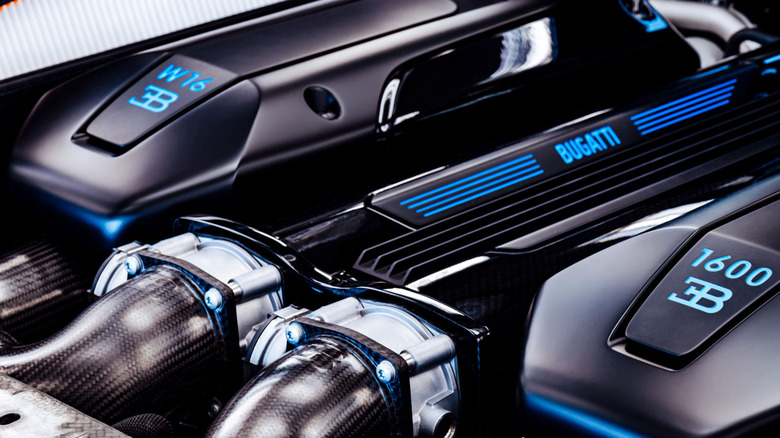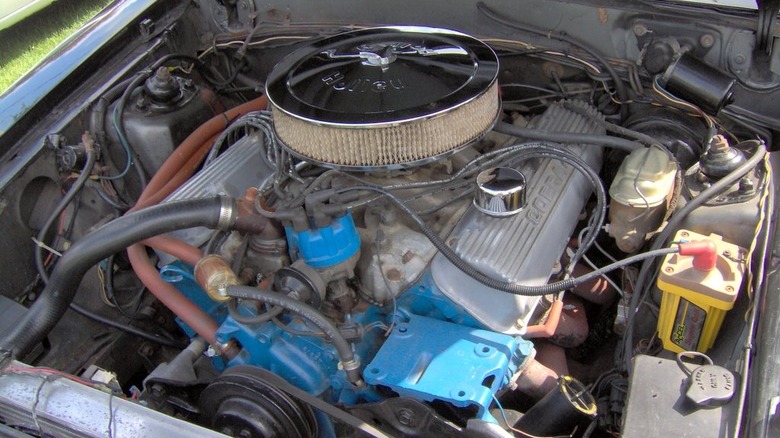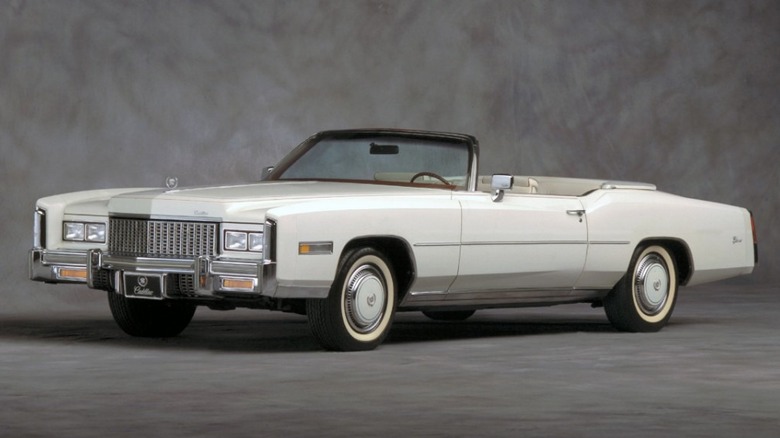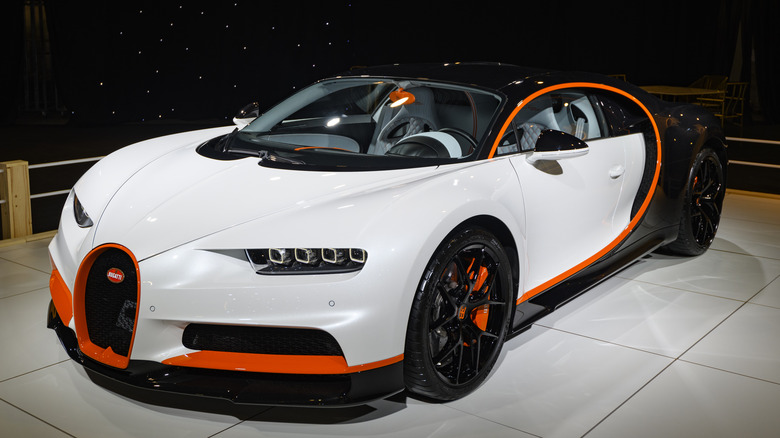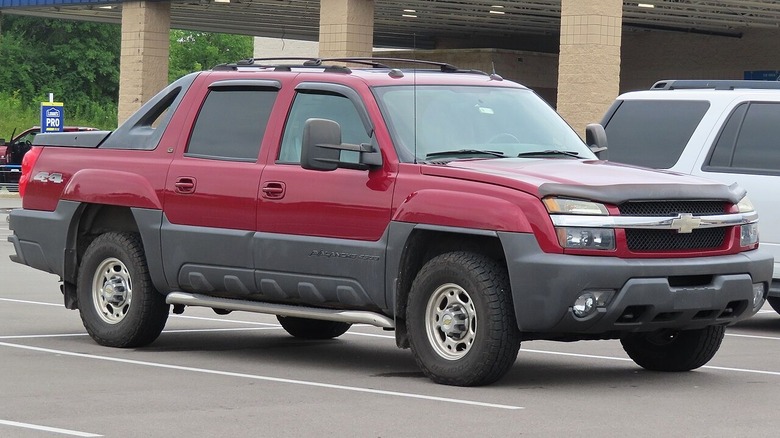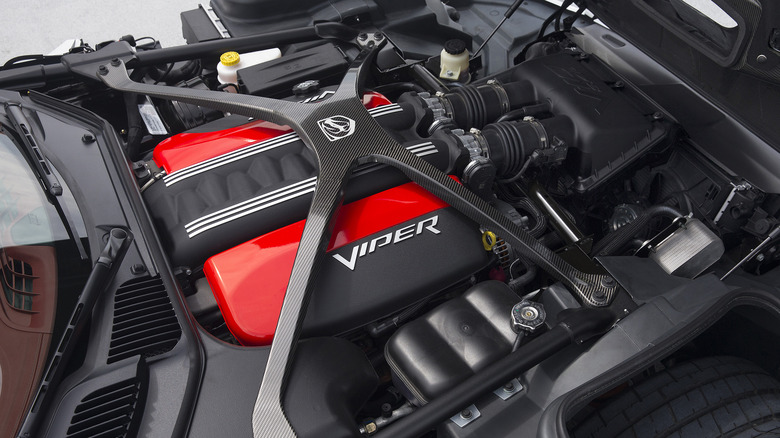5 Of The Biggest Car Engines Ever Sold In The U.S.
With fuel prices soaring and the electric vehicle juggernaut forging ahead at warp speed, the heyday of the large displacement internal combustion engine is almost surely in the rear view mirror. When the automobile was in its infancy, massive engines were a necessity, since that was the only method to produce sufficient horsepower using primitive technology.
Over one dozen pre-World War II cars from Bugatti, Daimler, and even Ford sported engines that surpassed 12 liters, but that's nothing compared to Fiat's S76 from 1910 — which boasted a simply massive 28.5 liter (1,739 cubic inch) four-cylinder. That's equal to more than ten of the 2.7-liter EcoBoost engines that power the new 2024 Ford F-150, which is no small vehicle.
In more contemporary times, the muscle car era ushered in a rebirth and rekindled interest in outsize engines, which also went to good use powering other less sporty, but heavy vehicles like pickup trucks and luxury land yachts like the Lincoln Continental that approached twenty feet long.
Even with the existence of modern trappings like turbochargers, direct injection, and variable valve timing, these stalwarts lend truth to the old expression that "there's no replacement for displacement" when it comes to speeding things up.
1968 to 1998 Ford 7.5-liter V8
If nothing else, Ford's 460 cubic inch (7.5 liter metric equivalent) V8 has some tenacious staying power. Derived from the brand's 429 cubic inch muscle car V8, the 460 was more focused on torque for motivating heavy luxury cars like those from Lincoln, which was the exclusive recipient of the 460 for its first several years.
Later, the motor would power more commonplace Fords such as the Thunderbird, and several generations of F-series pickup trucks. In its early guise, the 460 was rated for 365 horsepower and a stump-pulling 485 pound-feet of torque — though those "gross" measurements of the time would be lower in real world "net" terms that are used today.
Like other domestic big block V8s, the 460 was eventually choked by primitive emissions equipment and low octane fuel during the 1970s "malaise era," and leisurely produced only about 200 horsepower for all its largess. Over the following two decades, modern technology like fuel injection would redeem the biggest Ford V8, with net horsepower reaching 245 ponies and 485 pound-feet of torque by its final production year of 1998.
Due to its long production run and ready availability, the 460 remains a popular and budget friendly choice for modern drag racers and hot rodders. With a few performance parts like freer-flowing intake and exhaust manifolds, these former truck engines can make over 500 horsepower without even breaking a sweat.
[Featured image by sfoskett via Wikimedia Commons | Cropped and scaled | CC BY-SA 3.0]
1970 to 1976 Cadillac 8.2-liter V8
When Cadillac's 472 cubic inch (7.7 liters metric equivalent) V8 burst on the scene in 1968, it was — unbelievably — the brand's first totally "clean sheet" engine design since 1949. In 1970, the luxury automaker struck legendary status when it fitted the 472 with a longer-stroke crankshaft that punched its displacement out to a whopping 500 cubic inches, or 8.2 liters.
Exclusively offered in the Eldorado luxury coupe (and later convertible) for the first several years, Cadillac's 500ci V8 produced 400 horsepower and 550 pound-feet of torque, although once again, those are figures are old-style "gross" measurements which exaggerated the real world "net" horsepower output. Nonetheless, it was sufficient to pull the heavy front-wheel drive Eldorado from 0-60 MPH in 8.8 seconds, which was quite respectable at the time.
By the mid-1970s, clean-air emissions equipment like catalytic converters, and a lower compression ratio suited for unleaded gasoline, took their toll on Cadillac's flagship V8. In its final year of 1976, the previously burly big block was capable of only a paltry 190 horsepower and 360 pound-feet of torque.
Surprisingly, the Cadillac 500 enjoys something of a cult status today, perhaps because of a certain novelty factor from the luxury car association. Creative gearheads have shoehorned the big engine into a wide variety of cars and boats, including an AMC Gremlin on the MotorTrend show "Roadkill."
2005 to 2022 Bugatti 8.0-liter W16
Unlike some other automakers with their garden variety eight or even 10 cylinder engines, Bugatti took a different approach toward building massive horsepower and displacement for its Veyron supercar. Bugatti's 8.0-liter engine consists of an insane 16 cylinders configured in a "W" pattern — picture a pair of V8 engines stacked atop each other and sharing the same crankshaft. As if 16 cylinders wasn't enough, Volkswagen Group, the parent company of Bugatti, saw fit to also mount a brace of four turbochargers to pressurize the intake charge.
At the engine's debut in 2005, it made about 1,000 horsepower which could push its host vehicle to a top speed of approximately 250 MPH. In 2022 — the 8.0-liter W16's final year of production — horsepower had ballooned more than 50% to 1,578 ponies in the brand's Chiron Super Sport.
Said Chiron was able to sprint from 0-60 MPH in 2.2 seconds, a number that rivals the very quickest electric vehicles that will soon be replacing this remarkable achievement in internal-combustion.
2001 to 2006 Chevrolet Vortec 8.1-liter V8
You know this list wouldn't be complete without the inclusion of at least one big block Chevy. While the brand's iconic muscle car era big block V8 engines like the 427 and 454 (7.0 and 7.4 liters respectively) get the most love from enthusiasts, it's also worth revisiting the final iteration of that lineage which carried the torch into the early 21st century — the Vortec 8100.
Although Chevy has cooked up some much larger big blocks for sale to hot rodders in crate engine form, the 8.1-liter Vortec was the largest installed in a production vehicle for street use. Unfortunately, the 8.1-liter Vortec wasn't available in any cars, but you could get it in select General Motors pickup trucks, SUVs, cargo vans, and Chevy's strange half pickup/half SUV, the Avalanche.
In fact, Richard Rawlings of television's "Fast and Loud" fame once piloted a Vortec 8100 powered Avalanche in the Bullrun, an illegal Cannonball Run-esque endurance race across the United States. Depending on model year, this spiritual successor to the mighty 454 could crank out between 320 and 340 horsepower in stock form, along with 440 to 455 pound-feet of torque.
[Featured image by MercurySable99 via Wikimedia Commons | Cropped and scaled | CC BY-SA 4.0]
2008 to 2017 Dodge 8.4-liter V10
To the delight of gearheads and automotive journalists alike, Dodge greenlighted its bulging brute of a roadster — the Viper — for production in 1992. The first crop of Vipers sported an all-aluminum 8.0-liter V10 engine that was loosely based on adding two cylinders to Dodge's "LA" series of V8 engines that were previously powering police cruisers and pickup trucks.
Not content with a mere 8.0 liters, Dodge engineers grew the displacement of the Viper's signature V10 to a eye-popping 8.4 liters by 2008, where it stayed until the end of production in 2017. The 2013 and up iterations of the mighty 8.4-liter V10 are the most powerful, boasting 640 horsepower and 640 pound-feet of torque.
That's enough gusto to rocket a 2017 Viper from 0-60 mph in just 3.3 seconds on its way to a stop speed of 206 MPH. More than just a straight line bruiser, the Viper in ACR (American Club Racer) trim held more race track lap records than any other production car at the time of its discontinuation, including such fabled tracks as Laguna Seca and Road Atlanta.
For us mere mortals without bottomless bank accounts, Dodge was also kind enough to serve up its big V10 in a less exotic and detuned iron block version across its line of pickup trucks.
